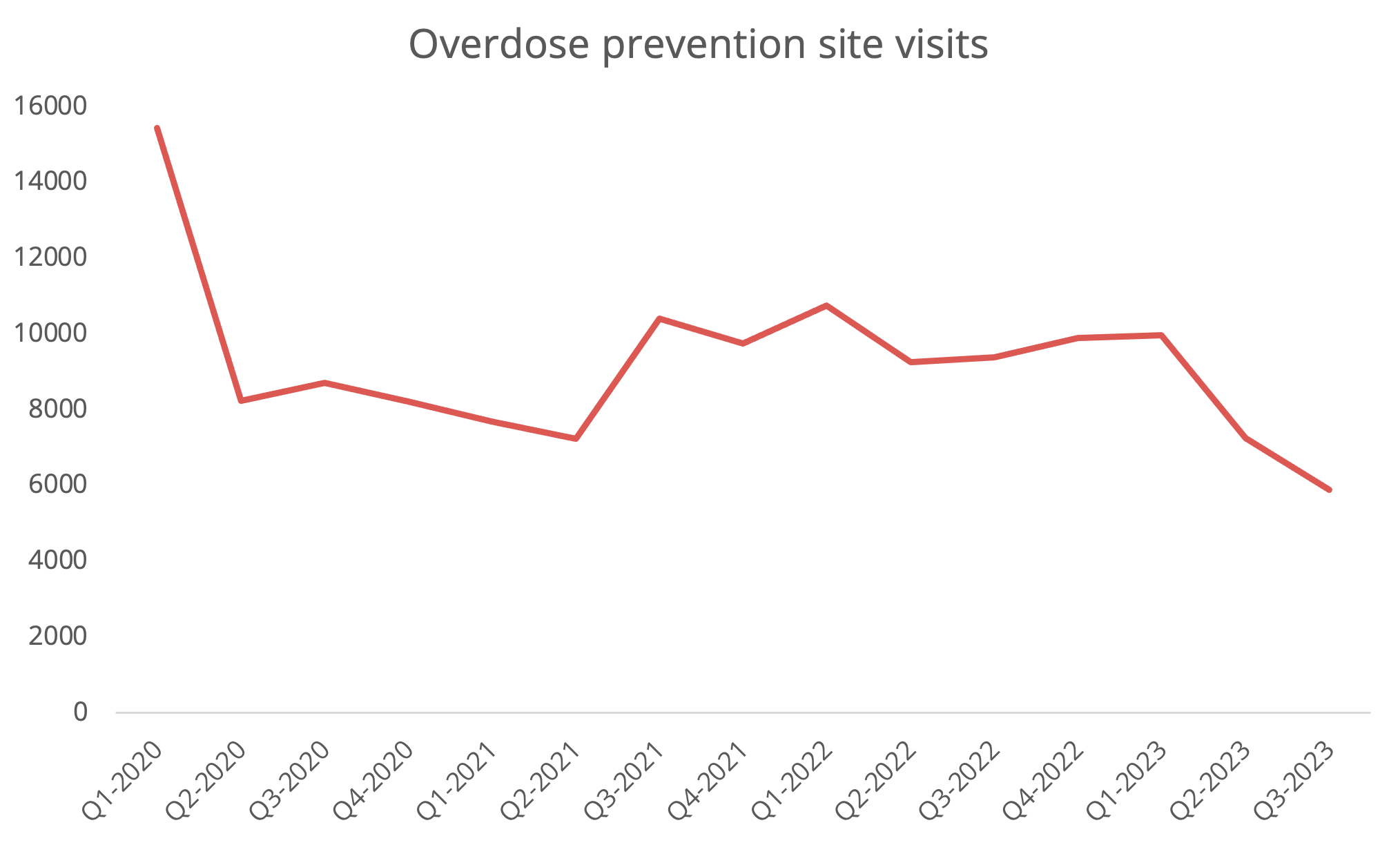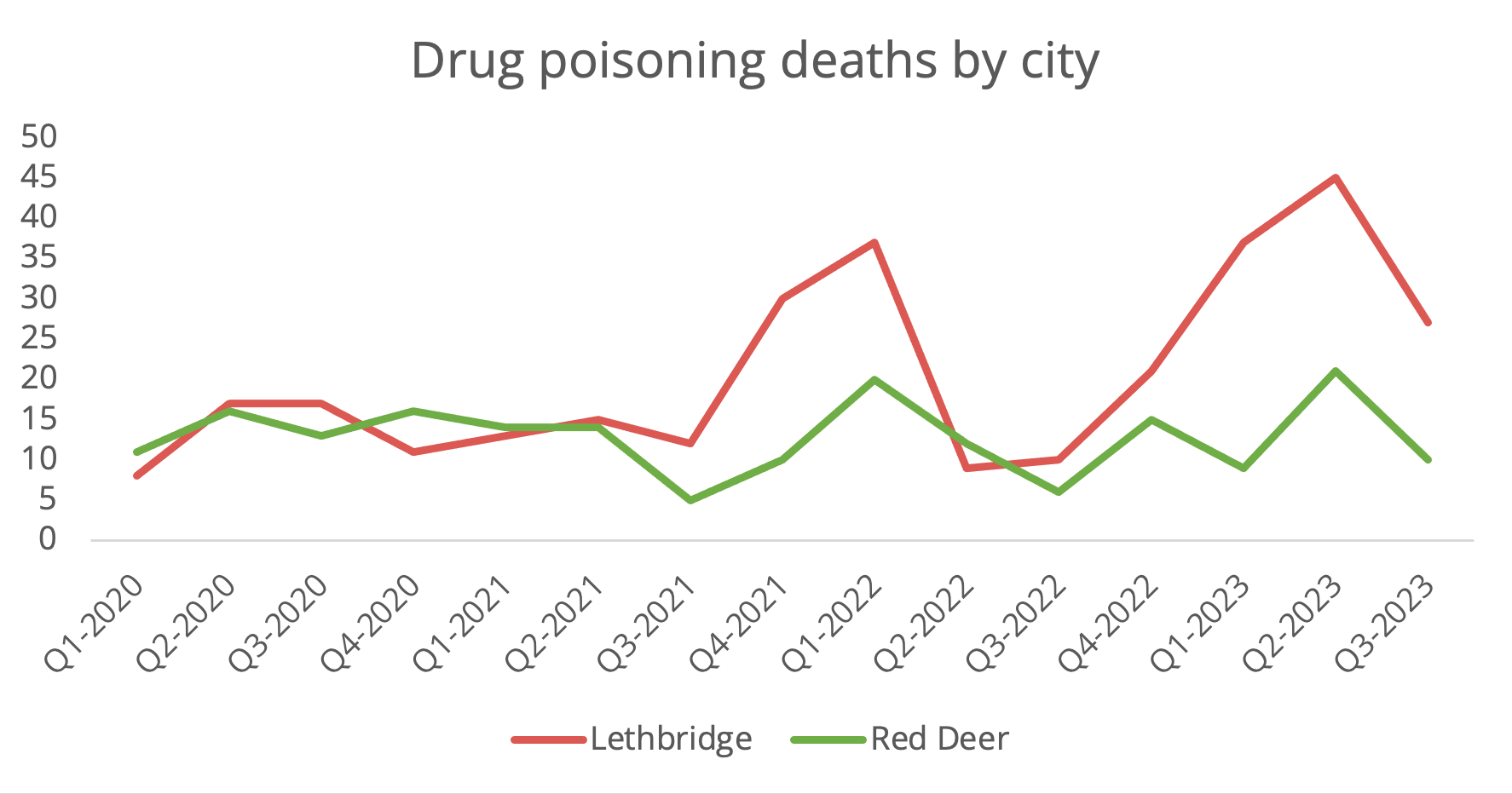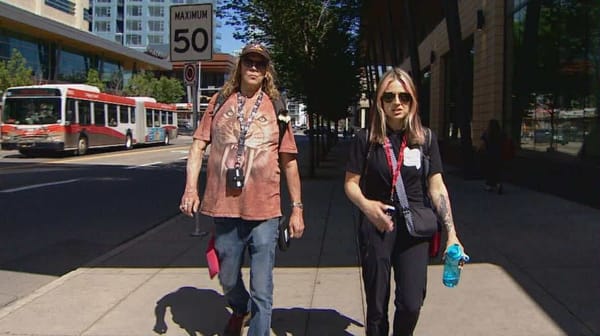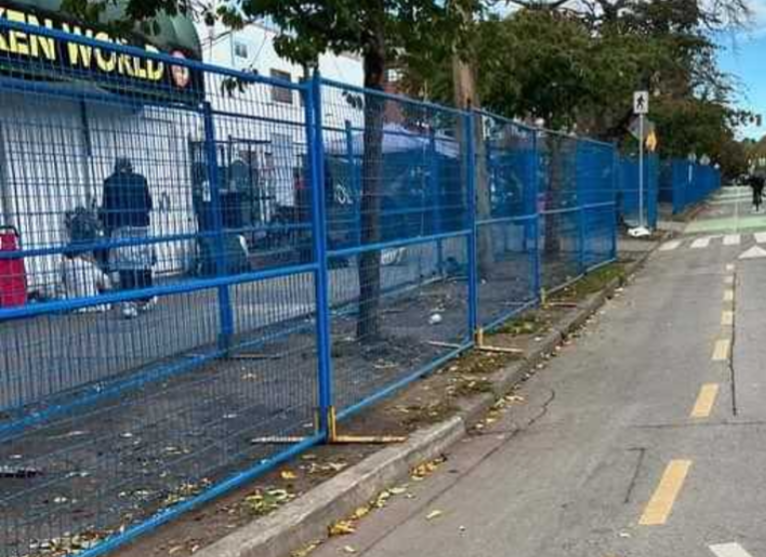Red Deer is galloping toward a cliff
Heralding a new phase in the Alberta government's war on harm reduction and hostile takeover of municipalities, closing the city's overdose prevention site could drive 28 preventable deaths a year.

Push a shopping cart north from Calgary or south from Edmonton about 30 hours, or drive an hour, and you’ll arrive at the drab pit stop known as Gasoline Alley. Behind that Wall Street curtain is among western Canada’s most interesting main streets, a rapidly evolving city of early-rising workers, quirky young businesses, a large student population, and a deeply troubled downtown core.
Having built the first of eleven privatized recovery communities in Red Deer, the Alberta government is sharpening the city as the tip of its ‘recovery-oriented’ spear. On Monday, January 22, Red Deer’s city council could be the first in Alberta to formally end safe drug consumption, plunging that spear into the soul of the city.
During their February 2023 announcement of a new detox (medicalized withdrawal) service at Calgary’s largest shelter, UCP cabinet members emphasized a strategy of replacing harm reduction services with abstinence-based programming. This runs counter to available evidence; nonetheless, the detox proceeded instead of the overdose prevention site that the shelter’s hapless executive team pitched to its unyielding neighbours the previous summer.
“It goes to the logic of… building out the recovery-oriented system of care, building out capacity for treatment… if we are continuing to experience the successes that we are experiencing, then… the pressures on [supervised consumption services] would inherently reduce.” -Former Mental Health & Addiction Minister Nicholas Milliken at the announcement for the Calgary Drop-In detox, responding to Alanna Smith, Globe & Mail
The “successes” to which Milliken was referring, sadly, were a temporary drop in fatalities. The true story was not released until after the May election. That month, Calgary Drop-In would issue a public warning as EMS, shelter and outreach workers struggled against record drug poisonings at the shelter and surrounding area.
At the time of the detox announcement in February, Drug Data Decoded was sounding the alarm that Alberta was likely undergoing a steep increase in deaths, based on sharply increasing non-fatal poisonings. It was eventually revealed that in April, at least 195 people were killed by unregulated drug poisoning—the province’s highest count ever.

What brought us to this moment in Red Deer?
In response to crisis-level drug poisoning deaths resulting from rapid opioid de-prescribing and the mass turn to unregulated fentanyl, eight supervised consumption sites were opened across the province from 2017 to 2019. The site in Red Deer was operated by Turning Point*. These sites would be the last to open in Alberta.
Instead, the new UCP government launched a smear campaign against harm reduction services, including a consent-manufacturing review of supervised consumption sites that served up baseless claims of crime and disorder while ignoring their proven impacts on health. This review has been dismantled in two peer-reviewed publications—the first by a criminologist at Dalhousie University and the second by a national group of clinicians, criminologists and public health experts.
The UCP’s campaign was paired with considerable expansion of so-called ‘recovery-oriented’ services, which can be summarized as corporate rehabs that lean heavily on free Christian 12-Step groups and use publicly funded services to funnel people in. The model’s central ‘innovation’ is increased virtual prescribing of opioid agonist medications manufactured by Indivior, an American company with a shameful legal history, long tentacles in medicine and considerable lobbying resources deployed in Alberta.
This system is being adapted to the provincial criminal justice system on the basis that people who commit crimes simply need to achieve abstinence from drugs—voluntarily or not.
Unfortunately, neither crime nor drug poisoning rates are positively impacted by a narrow focus on abstinence-based recovery.
Red Deer’s business operators and residents who don’t appreciate drug use in public are right to bristle at the current policy failure. Given the city’s sustained drop in overdose prevention site visits, there are now tens of thousands more consumption events annually in public spaces than pre-pandemic. This mainly reflects the widespread shift from drug injection to smoking, which is not accommodated in Red Deer’s overdose prevention site or anywhere else in Alberta since the UCP closed the ARCHES site in Lethbridge.

Many people also have a distaste for finding drug use debris including syringes and pipes. If you live in Red Deer, you may also be seeing that more frequently.
This makes sense: reduced visits to the overdose prevention site means drugs are being consumed elsewhere. People frequently use washrooms at these sites as well, so human waste may also be more publicly visible. These problems are not solved by reducing access to supplies or services.
The UCP government has long held the Red Deer overdose prevention site in its crosshairs. A year ago, city councillor Kraymer Barnstable publicly apologized after being overheard plotting the site’s closure with a “provincial colleague.” Coincidentally, in May 2023, the UCP government transferred control of the site’s operation from Turning Point to Alberta Health Services and converted it to a mobile site.
Red Deer South UCP MLA Jason Stephan is now openly “leading the charge” against the site, encouraging his constituents to attend Monday’s city council meeting. It is a mask-off moment for this government, which has repeatedly insisted supervised consumption services are part of its ‘recovery-oriented system of care.’
Return to the graph above, focusing on the big drop in site visits near the right side. After the first quarter of 2023, when AHS took over the site, visits plummeted 40% in just six months. In that period, as many as 7,000 drug consumption events occurred in public spaces around Red Deer—or alone at home—that would have been safely inside the overdose prevention site while it was run by Turning Point.
The UCP’s position on replacing harm reduction services with abstinence-based programming is magical thinking by which rehab has the power to stop public drug use. In fact, by having no impact on drug use or drug poisoning rates amidst a public health emergency, this approach is far worse than simply a waste of money.
What should Red Deer residents do?
While Red Deer city council’s apparent inclination to close its overdose prevention site is beyond comprehension, people are right to suggest that adjustments are needed.
First, city council could find ways to reverse declining attendance at its overdose prevention site. Councillors can learn from people’s experiences in Lethbridge, where closing down a highly trafficked site led to dozens of deaths in public over the coming years—everyday people finding bodies on their way to work or school.

Meanwhile, a study published by close allies of the UCP showed that every 1,146 supervised consumption site visits could prevent one fentanyl-related death.
With 33,000 visits to the Red Deer overdose prevention site in the last year, this means closing the site could drive 28 more preventable deaths per year. Are councillors comfortable carrying that for the sake of ducking a political fight?
In fact, expanding the site’s operation to accommodate smoking would help the site reach or exceed its pre-pandemic rate of 15,000 visits per quarter**. Based on the same study by friends of the UCP, this could reduce deaths in the city by as many as 8 every year. Red Deer residents have lost between 43 and 56 neighbours to drug poisoning every year since 2020.
Next—and if this seems counterintuitive, you are not alone—Red Deer residents should push hard for expanded opioid prescribing. A recent study in a top medical journal showed that all-cause deaths among people at high risk of opioid poisoning are reduced up to 91% through hydromorphone prescribing in BC. Additional peer-reviewed research shows reduced reliance on petty crime among people accessing regulated opioids that lessen the need for fentanyl.
Finally, advocate for housing and supports for the most vulnerable. Red Deer’s unhoused population jumped 140% from 144 (2018) to 334 (2022), a horrific trend largely attributable to low incomes. What many call ‘disorder’ in Red Deer’s downtown is in fact policy-driven poverty made visible. All levels of government have a role, but the Province’s attacks on disability and youth supports, and its refusal to implement rent control and other market interventions, are actively exacerbating the problem.
What do businesses and downtown residents stand to gain?
- Reduced public drug use and debris, human waste, drug poisonings in public, EMS calls, and overflowing emergency rooms.
- Increased service access by people who use drugs, community safety and health care access for everyone, and the chance for Red Deer to gallop ahead of this province in the right direction.
Update: On January 22, Red Deer city council moved to delay the debate and vote on the notice of motion to close the overdose prevention site until February 15. Read more from local outlets RD News Now and Red Deer Advocate.
*An earlier version erroneously suggested that in addition to previously operating the overdose prevention site, Turning Point also operates a shelter in Red Deer. It does not: the author accidentally mixed up Turning Point with Safe Harbour.
**An earlier version erroneously stated 15,000 visits per month in the text description. This corrected version shows 15,000 visits per quarter. All graphs remain unchanged.





